![]()
Wednesday, October 28, 2015
Originally published by The Meir Amit Intelligence and Terrorism Information Center under the title “What Direction Will the Current Wave of Palestinian Terrorism Take? Possible future trends expressed in Palestinian political and media discourse”. It’s reprinted here for your convenience.
Palestinian Political Discourse and Media
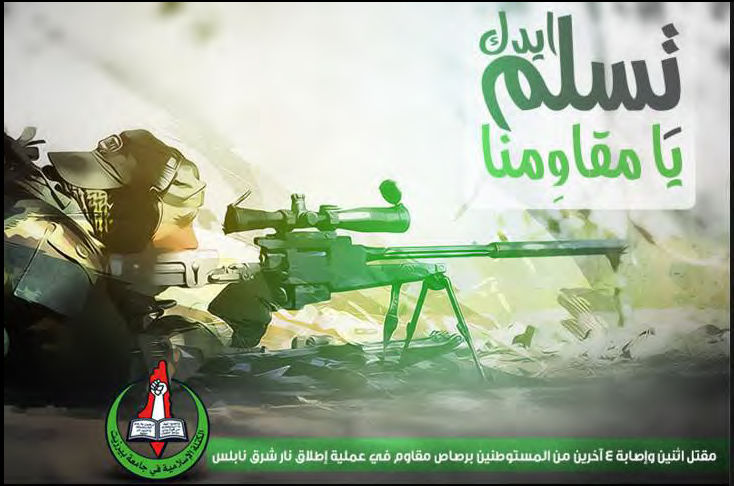
A posting on the Facebook page of Hamas’ Islamic Bloc, its student faction at Bir Zeit University (near Ramallah). It appeared after the shooting attack near Itamar that killed the Henkins on October 1, 2015 (at the beginning of the current wave of Palestinian terrorism). It praised the terrorist operatives who shot the couple. The Arabic reads, “May your hands be blessed, oh fighters of our resistance” (Facebook page of the Islamic Bloc at Bir Zeit University, October 1, 2015). The posting reflects Hamas’ desire to turn the so-called “popular resistance” into an armed campaign that would also include shooting attacks (as opposed to the Palestinian Authority’s concept of “popular resistance”).
After approximately a month and a half of violence and terrorism in Israel, Judea and Samaria, the Palestinian Authority (PA) and Palestinian media still deal intensively with events. What Israel regards as a wave of violence and terrorism is consistently represented by the Palestinians as the “executions” of innocent civilians rebelling against Israel and engaged in a “popular resistance.” Israel is represented as using arbitrary and excessive force against individuals (“cold-blooded executions”) and employing “collective punishment” (imposing restrictions on the residents of the east Jerusalem neighborhoods).
The wave of violence and terrorism continues, with terrorist attacks shifting from one arena to another (in Jerusalem, deep inside Israel, and recently in Hebron and Gush Etzion). In the meantime, Palestinian politicians and media commentators maintain an ongoing discourse about the events and their significance, following them and even recommending the desirable direction for their continuation, and exploiting them to promote Palestinian national objectives. In the Palestinian political discourse and media there are two prominent, opposing concepts as to how events should proceed:
- Continuing the violence and terrorism, based on the concept of “popular resistance:” That is the concept advanced by the PA and Fatah, and has the most support from the Palestinian media (both affiliated with the PA and independent). It aspires to have the current Palestinian “eruption” channeled into a “wise popular resistance” (muqawama al-rashida). That kind of resistance can be maintained over time with increasing and decreasing levels of intensity, on the assumption (covert but occasionally overt) that eventually the Palestinians will exhaust Israel and force it to make political concessions. Senior PA figures and most of the political commentators oppose turning the “popular arising” into an “armed intifada” of the sort advocated by Hamas, for a variety of reasons: such a situation could lead to the PA’s losing control, serve Hamas’ political interests in Judea and Samaria, damage the fabric of society and the Palestinian economy, show the Palestinians to the world as responsible for Israel’s so-called “extreme violence” and give Israel justification to take harsh measures against the Palestinians.
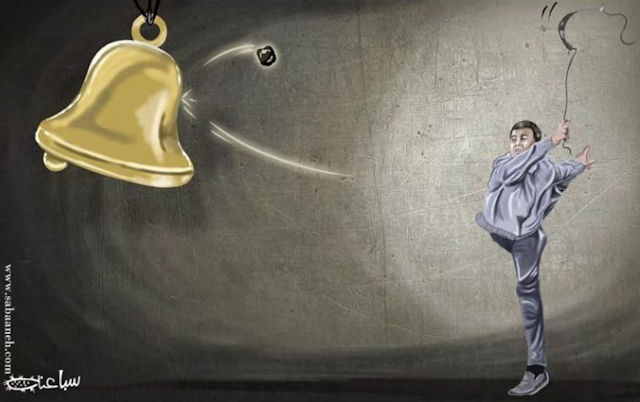
Picture using the stone as a symbol of the “popular resistance” striking the bell, a metaphor for awakening the Palestinians and promoting their national goals (Al-Hayat Al-Jadeeda, PA’s organ, October 21, 2015).
- Maintaining the current wave of “popular resistance” and turning it into an armed conflict and the third intifada: That is the concept promoted by the Hamas leadership and is echoed by its media. Hamas does not reject the “popular resistance,” and explicitly calls for an intensification of the wave of stabbing and vehicular attacks. However, it does not regard the “popular resistance” as the only strategy and seeks to turn it into a jihad and third intifada (calling it the “Jerusalem intifada”). For Hamas, that means combining the continuation and intensification of the “popular resistance” (that is, shooting attacks, abducting IDF soldiers as bargaining chips and suicide bombing attacks) with military-type terrorist attacks. Senior Hamas figures and the Hamas media repeatedly preach turning the current wave of Palestinian terrorism into the “third intifada,” directed by a united Palestinian leadership (while in reality Hamas seeks to direct and control the attacks[1]).
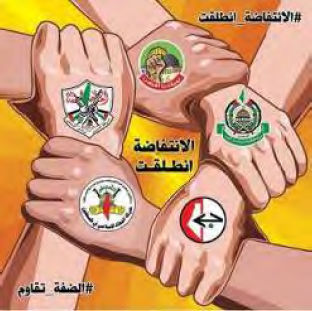
Hamas calls on all the Palestinian organizations, including Fatah, to join forces for an intifada in the West Bank (Facebook page of PALDF, October 8, 2015). The picture expresses Hamas’ desire for all the organizations to join forces and turn the spontaneous popular intifada into an organized intifada directed by a united leadership.
- The political and public discourse in Judea and Samaria clearly illustrate the dilemma faced by the PA. On the one hand, it is in the PA’s interest to maintain the current wave of violence, which is in line with its policy of “popular resistance,” and in the future to use it as a tool to extract political concessions from Israel in the international arena. On the other hand, the PA is aware of the potential risks involved in continuing the current wave of terrorism, to say nothing of intensifying it. To obviate such risks it is clearly in the PA’s interest to control the intensity and degree of attacks (even though it cannot always do so) and prevent the “popular resistance” from losing its popular character, which is liable to serve Hamas and challenge Fatah and the PA’s domination of Judea and Samaria.
- Beyond the basic dispute between Hamas and the PA, political and media discourse in Judea and Samaria seem to agree that the “popular resistance” (i.e., popular terrorism) has to continue, and that there is no alternative, such as complete quiet and the end of popular terrorism, without far-reaching political compensation from Israel.[2] While reservations have been expressed in the media about the stabbing attacks which lead the current wave of popular terrorism, they are the exception.[3]
- Thus without a fundamental change in the pattern of Israeli-Palestinian relations (which is apparently not on the horizon), the complete cessation of Palestinian popular terrorism is not a realistic alternative (as far as the PA is concerned). The PA (and Fatah) can therefore be expected to continue supporting popular terrorism and its manifestations, with rising and falling frequency and intensity (throwing stones and Molotov cocktails, and the use of “cold weapons” in stabbing and vehicular attacks will continue to be considered “legitimate”). At the same time, the PA will continue to represent popular terrorism to international (and Palestinian) public opinion as a “peaceful popular resistance” which the Palestinians have the right to pursue until the Israeli occupation ends.
Appendix: A Selection of Op-Ed Pieces from Judea and Samaria Dealing with Possible Directions for the Current Wave of Palestinian Terrorism
Yahya Rabah, senior Fatah figure in the Gaza Strip (in Al-Hayat Al-Jadeeda, the daily PA establishment organ, October 28, 2015): In an article titled “Where is the Palestinian awakening going?” Rabah attacked the declarations of American Secretary of State John Kerry, which, he claimed, did not support the Palestinian people, did not help end the occupation and encouraged the Israeli prime minister to punish the residents of east Jerusalem by revoking their Israeli IDs. Therefore, claimed Rabah, the current wave of “Palestinian awakening” had to continue. It was, he claimed, the Palestinians’ right, decision and national achievement.
Dr. Ghassan al-Masri, director of the Canaan center for information and research (October 24, 2015): In an article titled “What the lull needs to achieve,” he called for the Palestinians to formulate their demands and present them as a condition for a lull. Among the demands he listed the following: an end to Israelis’ entering the Temple Mount, the end of building in the settlements, stopping the “settlers’ aggression towards the Palestinians,” the release of all the Palestinians imprisoned in the intifada and compensation for the families of the shaheeds. That would be the basis for a return to negotiations for a two-state solution and the establishment of a Palestinian state. Dr. al-Masri claimed that any surrender to pressure and agreeing to a lull with nothing in return from the Israelis would undermine the legitimacy of the Palestinian leadership and create the risk of a new intifada.
Dr. Abd al-Majid Suwailam (Al-Ayyam, October 22, 2015): Dr. Suwailam wrote that the suicide bombing attacks would lead only to harming the image of the current Palestinian “awakening,” which is a “peaceful popular resistance.” Future suicide bombing attacks would harm Israeli civilians who are not part of the “system of occupation” operating in the occupied Palestinian territories.
Dr. Abd al-Majid Suwailam (Al-Ayyam, October 22, 2015): Dr. Suwailam strongly rejected the calls heard among Palestinians to escalate the current confrontation with Israel and turn it into an “armed struggle.” The calls, he said, came from Hamas supporters, as opposed to the “patriotic” demonstrators at the focal points of friction with Israel. He said the Palestinians had to continue their struggle using “popular tools” and to avoid an armed escalation with Israel.
Al-Hayat Al-Jadeeda (October 21, 2015): An editorial stated the intifada had to be conducted “wisely” and represented to the world as a just Palestinian struggle against a cruel occupier. The shaheeds, it said, brought honor and glory to the Palestinian people but the Palestinians did not need “cataracts of blood.” The Palestinian people had to aspire to be heroes who would not die but live, and celebrate victory with their families when the time came.
Ashraf al-Ajrami (Al-Ayyam, October 21, 2015): Al-Ajrami wrote that Israeli society was currently confused. The Israeli right had carried away most of the Israeli public with its violent approach. The Israelis wanted [to achieve] an end to the current wave of violence only through the use of acts of punishment. The question now was whether the Israeli public thought the confrontation could be continued infinitely, or whether they would try to achieve peace by openly recognizing the right of the Palestinian people to establish a state with the 1967 borders and east Jerusalem as its capital.
Hani al-Masri (Al-Ayyam, October 20, 2015): Al-Masri wrote that in the current situation it would be impossible to wage an “armed resistance.” An “armed resistance,” he said, would serve the interests of Israel by presenting the Palestinians as responsible for the extreme violence, and would be used by Israel as an excuse for the mass slaughter of Palestinians. It was possible to wage an “intifada in waves,” whose objective would be to undermine concrete Israeli plans, such as “economic peace” or absorbing areas of east Jerusalem into Israel.
Hafez al-Barghouti (Al-Hayat Al-Jadeeda, October 20, 2015): Al-Barghouti negated the worth of carrying out suicide bombing attacks in Israel, for which there was no national consensus. Suicide attacks, he wrote, would only lead to loosening the restraints on “the Israeli terrorist government” and motivate it to use all its force against the Palestinian people in the West Bank and Gaza Strip.
Muafaq Matar (Al-Hayat Al-Jadeeda, October 20, 2015): Matar wrote that the Palestinians had hurt the image of the Israeli defense institution. Videos of Israeli soldiers running away from Palestinians holding knives showed a decrease in the morale of the Israeli army. It was, he claimed, the result of young Israelis drafted into the IDF having “their eyes opened” and understanding that they were wearing the uniform of “an army of occupation.”
Al-Hayat Al-Jadeeda (October 20, 2015): An editorial was published titled “The wise popular resistance (al-muqawama al-rashida) calls for calm in the West Bank.” The editorial advised maintaining what it referred to as the “correct balance” between the spirit of resistance and the daily needs of the population. It stressed that the Palestinians wanted to live their lives and had no interest in widening the circle of bloodshed.
Naji Sadeq (Al-Quds, October 19, 2015): Sadeq wrote that the PA was put at serious risk by the dynamics of the current escalation. There was concern in the West Bank that political forces hostile to Mahmoud Abbas [a hint at Hamas] would exploit the weakness of the regime to establish themselves and reshape the Palestinian arena. Under certain conditions young Palestinians in the street were liable to turn their rage against the PA itself.
Nasr al-Laham (Ma’an News Agency, October 19, 2015): Al-Laham wrote that there were naïve people asking the Palestinian leadership to condemn knife attacks and violence. That was stupidity because the knives were the result, not the cause. To deal with the situation seriously the Palestinians had to get rid of the Israeli occupation, the settlements, extremism, hatred and racism. The current situation would continue without change for months and years in various forms. In the future it might simultaneously include an intifada, acts of attrition and civil disobedience.
![]()
Notes:
[1] A recent statement to that effect was made by Khaled Mashaal, head of Hamas’ political bureau, who held a press conference during a visit to South Africa. He called for all the Palestinian forces, including Fatah, to establish “a united national leadership for intifada and resistance.” He called on Mahmoud Abbas to “bear the responsibility with us and make common decisions” (Al-Jazeera, October 21, 2015).
[2] A current example is the statement of Nimr Hamad, Mahmoud Abbas’ political advisor, who said, “If the [Israeli] occupation continues, it is impossible for there to be no resistance.” The “resistance,” he said, could be either “peaceful” or “armed.” The Palestinian leadership, he claimed, wanted “a peaceful popular resistance” [that is, popular terrorism}, and wanted to distance itself as far as possible from another round of violence (Interview with the Egyptian channel CBCextra, October 24, 2015).
[3] That opinion is held by Muhammad Daraghmeh, a prominent journalist in Ramallah, who published an editorial calling for young Palestinians not to carry out stabbing attacks. Its title was “Don’t go to [your] death.” He called on young Palestinians to go out into the streets and to the roadblocks, to shout and make themselves heard, but not to die for the homeland. He said that anyone who carries a knife and attacks a soldier is committing suicide. He added that the world the Palestinians are trying to enlist to their side objects to stabbing and vehicular attacks as it objects to suicide bombing attacks (Al-Hadath, October 18, 2015).



 RSS
RSS

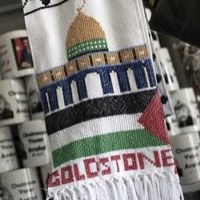
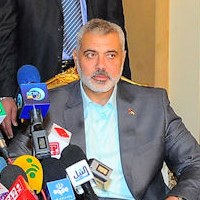
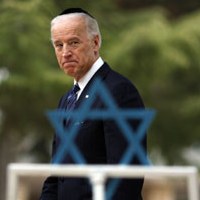
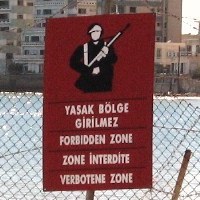





Latest Comments
Hello Mike, Thank you for your positive feedback to the article. I felt there wasn’t too much critical analysis of ...
Thanks for this considered and well constructed article. A follow up article on the manner in which the editorial contro...
THE CLUELESSNESS OF CLAIMING THAT OBAMA'S MIDDLE EAST POLICIES WERE A FAILURE CANNOT BE FURTHER FROM THE TRUTH, WHAT THE...
As long as Obama is the president of the usa do not trust the us government......
Thank you for an good read....